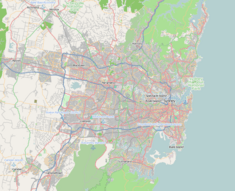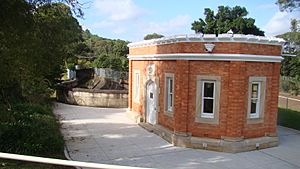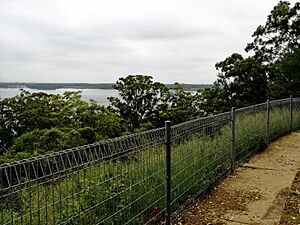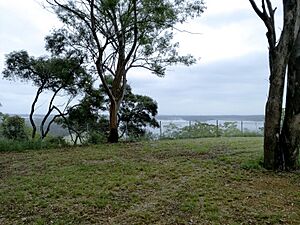Prospect Reservoir facts for kids
Quick facts for kids Prospect Dam |
|
|---|---|
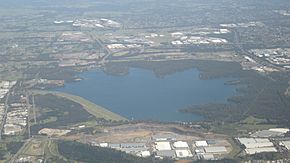
Aerial view of Prospect Reservoir looking west
|
|
|
Location of Prospect Reservoir in
New South Wales |
|
| Country | Australia |
| Location | Western Sydney, New South Wales |
| Coordinates | 33°49′41″S 150°53′56″E / 33.828°S 150.899°E |
| Purpose | Potable water supply |
| Status | Operational |
| Opening date | 1888 |
| Owner(s) | Sydney Catchment Authority |
| Operator(s) | Sydney Water |
| Dam and spillways | |
| Type of dam | Embankment dam |
| Impounds | Prospect Creek |
| Height | 26 m (85 ft) |
| Length | 2,225 m (7,300 ft) |
| Dam volume | 2,892×103 m3 (102.1×106 cu ft) |
| Spillways | 1 |
| Spillway type | Uncontrolled |
| Spillway capacity | 230 m3/s (8,100 cu ft/s) |
| Reservoir | |
| Creates | Prospect Reservoir |
| Total capacity | 50,200 ML (1,770×106 cu ft) |
| Catchment area | 9.7 km2 (4 sq mi) |
| Surface area | 5.25 km2 (2 sq mi) |
| Maximum water depth | 24 m (79 ft) |
The Prospect Reservoir is a very important place in Western Sydney, Australia. It holds a huge amount of water for drinking, about 50,200 megalitres! This reservoir was created by the Prospect Dam, which crosses Prospect Creek. It's located in the suburb of Prospect.
The eastern part of the reservoir is a fun recreational area where people can visit. The western side is part of the Western Sydney Parklands. This whole area was added to the New South Wales State Heritage Register in 1999 because of its special history.
Prospect Reservoir is the biggest reservoir in Sydney. It stores water that comes from other dams like Warragamba Dam and the Upper Nepean Dams. This water is then sent to homes and businesses across Sydney. The dam itself is an earth wall, 26 metres high and about 2.2 kilometres long.
Contents
Building Sydney's Water Supply
Early Plans for Water
In 1867, the government of New South Wales decided to find a better way to supply water to Sydney. By 1869, they chose a plan called the Upper Nepean Scheme. This plan involved building structures to collect water from the Nepean River and other nearby rivers.
Water would travel through tunnels, canals, and aqueducts. These channels would carry the water by gravity to a new reservoir at Prospect. This was a big step for Sydney's water system, following older methods like the Tank Stream.
Constructing Prospect Dam
Prospect Reservoir was the first dam of its kind in Australia. It was an earthfill dam, meaning it was built using layers of compacted earth. The dam was finished in 1888. Its main job was to store water from the Upper Nepean Scheme.
The scheme diverted water from the Nepean, Avon, and Cordeaux Rivers. This water flowed through a long system of tunnels and channels. It ended up at Prospect Creek, where the dam wall was built. When it was completed, Prospect Reservoir became the main storage for Sydney's water.
Keeping the Dam Strong
Over the years, the dam needed some repairs to fix parts that had sunk. These repairs happened between 1893 and 1916. Later, in 1960, the much larger Warragamba Dam was finished. Prospect Reservoir still played a key role in Sydney's water supply.
A second pipeline was added in 1966 to connect Warragamba and Prospect. This allowed more water to be moved during busy times. In the late 1970s and again in 1997, the dam wall was made even stronger.
How Water is Filtered Now
In 1996, the Prospect Water Filtration Plant was built. This plant cleans the raw water before it goes to homes. Now, water from Warragamba and the Upper Nepean Dams usually goes straight to this plant.
However, the filtration plant can still get water from Prospect Reservoir if needed. The reservoir now acts like a large holding tank. It helps manage daily changes in water demand and can be used if there's a problem with water quality from other sources.
Outlet System for the Reservoir
Before the water filtration plant was built, water flowed from the reservoir through a special outlet system. This system included an outlet tower in the water and a valve house on land. These parts controlled the water going into the Lower Canal.
The outlet tower is a small, eight-sided brick building in the reservoir. You can reach it by a metal walkway. Inside, there are platforms and ladders. The water then travels through a tunnel to the Lower Valve House.
The Lower Valve House looks similar to the outlet tower. It used to control water entering the Lower Canal. Even though the Lower Canal is no longer used, much of the original equipment in the valve house is still there. This system is now mainly used to drain the reservoir if needed for safety.
What Prospect Reservoir Looks Like
Prospect Reservoir is now mainly a service reservoir and a place where sediment can settle. The dam wall is 2210 metres long. It has a clay core with earth layers on either side, all compacted tightly. It was finished in 1888, and its top level was raised slightly in 1898.
The side of the wall facing the water is covered with thick, locally sourced rocks. The area around the reservoir, owned by Sydney Water, includes:
- The reservoir itself.
- A spillway (a channel for excess water) at the southern end.
- Drains and monitoring tools at the bottom of the dam wall.
- An access road along the bottom of the dam wall.
- The outlet system that connects the reservoir to the old Lower Canal.
The heritage listing for Prospect Reservoir includes the dam, the surrounding landscape, and all related buildings like pumping stations. It also covers older items from the 1920s and 30s, such as pumping stations and a large water pipe built in 1937. More modern parts, like those from the Warragamba Supply Scheme, are also included.
Nature Around the Reservoir
The area right around the reservoir is mostly covered in plants and trees. This bushland was cleared long ago but has grown back. It is now one of the best examples of native bushland in Western Sydney.
This type of bushland is called Cumberland Plain Woodland. It is listed as an endangered ecological community, meaning it's very important to protect. Even though some parts of the bushland are not perfect, this site is very important for nature. If it were restored, it would help connect different natural areas, especially with the plants along Eastern Creek.
How Prospect Reservoir is Used Today
Since the Prospect Water Filtration Plant opened in 1996, water is usually not taken directly from Prospect Reservoir for drinking. Instead, water is piped straight from Warragamba Dam to the cleaning plant.
However, the reservoir is still a key part of Sydney Water's storage system. It's expected to be used for water supply only a few days every five years on average. Many people visit the site each year. Its recreational use is carefully managed to make sure the water stays clean enough to be used if needed.
Fun Activities at the Reservoir
The reservoir has a large recreational area on its eastern side. This area has many parks with places for picnics, lookouts, and BBQs. You can get to the reserve from William Lawson Drive, which connects to the Western Motorway or Prospect Highway.
Prospect Reservoir is open to the public during the week and on weekends. It is closed on public holidays. During daylight saving time, it's open from 6:00 AM to 6:30 PM. In non-daylight saving time, it's open from 7:00 AM to 4:30 PM.
Why Prospect Reservoir is Special
Prospect Reservoir is historically very important for Sydney. It has been supplying water to the city for over 120 years. It still works much like it did when it was first built. This shows how clever and advanced its design and construction were.
The reservoir shows three big changes in city life in the late 1800s:
- The growth of public services like water supply.
- The need for a reliable and steady water source.
- How governments started working together on large public projects.
Built between 1882 and 1888, it was an amazing engineering achievement for its time. It used new and clever building methods. It is also linked to important government departments and water authorities like the Sydney Catchment Authority.
The reservoir area is also beautiful, with its large body of water, parklands, and bush. It's a valuable place for relaxing and enjoying nature, breaking up the busy city landscape. People have been coming here for fun for many generations.
The reservoir and its surrounding area were added to the New South Wales State Heritage Register in 1999. This means it is considered rare and important for the history and science of New South Wales. It is also seen as a good example of beautiful local landscapes.
Engineering Award
The dam has received a special award called a Historic Engineering Marker from Engineers Australia. This award recognizes its importance in engineering history.
Images for kids


